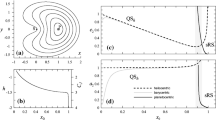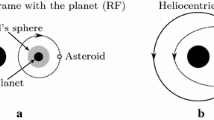Abstract
Now we use the Jacobian integral of circular restricted three-body problem to establish a testing function of the stability of satellites. This method of criterion may be applied to the stability problem of satellites when the six elements of the instantaneous orbit of the satellite with respect to its parent planet are known.
By means of an electronic computer, we can find the stable region of a satellite with a quasi-circular orbit. The boundary surface of this region is a nearly oblate ellipsoid. The volume of this enclosed space is much smaller than that of binding by Hill surface and that of “sphere of action”.
As the expressions of relative kinetic energy of a satellite with respect to its parent planet have the same form for the direct as well as the retrograde orbits, they can coexist in the same region at the same time.
Similar content being viewed by others
References
Wong Chia-ho, Why we have not yet found a retrograde planet in the solar system?Appl. Math. and Mech.,11, 5 (1990), 421–428.
Smart, W. M.,Celestial Mechanics (1953), 21.
Encyclopedia, China (1980), 529. (in Chinese)
Ehricke, Krafft A.,Space Flight, 1 (1960), 124.
Author information
Authors and Affiliations
Rights and permissions
About this article
Cite this article
Chia-ho, W. Why can the major planets have their satellites moving in direct and retrograde orbits as well?. Appl Math Mech 12, 339–343 (1991). https://doi.org/10.1007/BF02020396
Received:
Issue Date:
DOI: https://doi.org/10.1007/BF02020396




